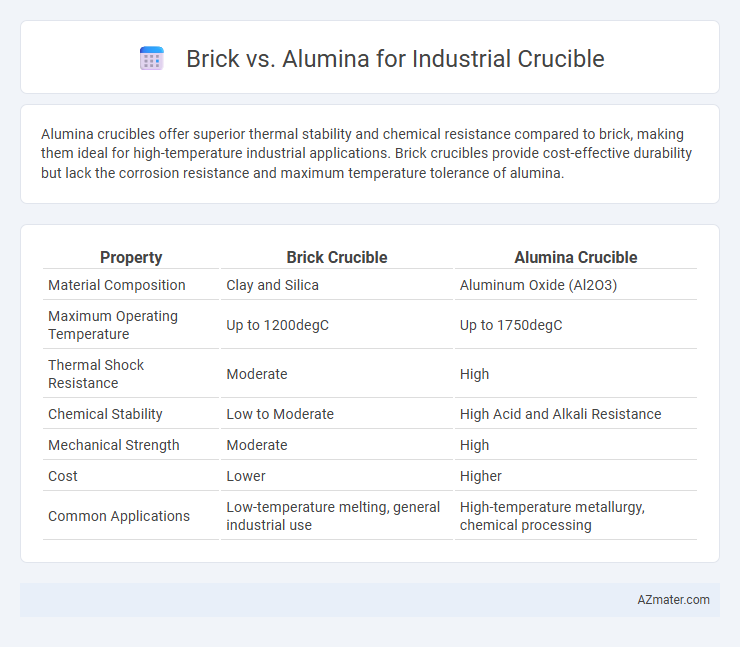Alumina crucibles offer superior thermal stability and chemical resistance compared to brick, making them ideal for high-temperature industrial applications. Brick crucibles provide cost-effective durability but lack the corrosion resistance and maximum temperature tolerance of alumina.
Table of Comparison
| Property | Brick Crucible | Alumina Crucible |
|---|---|---|
| Material Composition | Clay and Silica | Aluminum Oxide (Al2O3) |
| Maximum Operating Temperature | Up to 1200degC | Up to 1750degC |
| Thermal Shock Resistance | Moderate | High |
| Chemical Stability | Low to Moderate | High Acid and Alkali Resistance |
| Mechanical Strength | Moderate | High |
| Cost | Lower | Higher |
| Common Applications | Low-temperature melting, general industrial use | High-temperature metallurgy, chemical processing |
Introduction: Understanding Industrial Crucibles
Industrial crucibles are essential for high-temperature processes, with brick and alumina representing two primary material choices. Brick crucibles offer durability and cost-effectiveness, while alumina crucibles provide superior thermal resistance and chemical stability. Selecting the appropriate material depends on process temperature, chemical reactivity, and longevity requirements in metallurgical and ceramic manufacturing.
Material Overview: Brick vs Alumina Crucibles
Brick crucibles, typically made from fireclay or silica, offer excellent thermal shock resistance and affordability for general industrial melting processes. Alumina crucibles, composed primarily of aluminum oxide, provide superior chemical inertness, high melting points above 2072degC, and exceptional wear resistance, making them ideal for high-temperature applications involving aggressive materials. The choice between brick and alumina crucibles depends on factors such as temperature requirements, chemical compatibility, and desired lifespan in specific industrial environments.
Thermal Resistance Comparison
Alumina crucibles exhibit superior thermal resistance compared to brick counterparts, enduring temperatures up to 1750degC without deformation. Brick crucibles typically withstand lower temperatures around 1200degC to 1400degC, limiting their use in high-temperature industrial processes. The high thermal stability and low thermal expansion of alumina make it ideal for applications requiring rapid temperature changes and prolonged exposure to intense heat.
Chemical Durability and Reactivity
Brick crucibles exhibit moderate chemical durability but tend to react with acidic and basic slags, limiting their lifespan in aggressive environments. Alumina crucibles offer superior chemical resistance, maintaining stability and inertness even when exposed to corrosive metal melts and slags at high temperatures. The high purity and density of alumina result in minimal reactivity, making it the preferred choice for prolonged use in industries requiring contamination-free molten materials.
Mechanical Strength and Wear
Brick crucibles offer moderate mechanical strength suitable for low to medium temperature applications, but their wear resistance declines significantly under high thermal and abrasive stress. Alumina crucibles exhibit superior mechanical strength combined with exceptional wear resistance, maintaining structural integrity in high-temperature, chemically aggressive industrial environments. The high purity and dense microstructure of alumina contribute to enhanced longevity and consistent performance during extended use in metal melting and chemical processing.
Temperature Tolerance Limits
Brick crucibles typically withstand temperatures up to 1,800degC, making them suitable for general industrial melting applications. Alumina crucibles offer superior temperature tolerance, enduring thermal environments as high as 1,750degC to 1,850degC with enhanced chemical resistance and thermal shock resilience. Choosing alumina over brick can extend operational lifespan in processes requiring consistent exposure to extreme heat levels above 1,700degC.
Cost Analysis: Initial and Lifetime Expenses
Brick crucibles typically have a lower initial cost compared to alumina crucibles, making them a budget-friendly option for many industrial applications. However, alumina crucibles offer superior durability and thermal resistance, leading to a longer lifespan and reduced replacement frequency in high-temperature environments. Evaluating total lifetime expenses, alumina crucibles often provide better cost-efficiency despite their higher upfront investment due to lower maintenance and downtime costs.
Maintenance and Longevity
Brick crucibles, made from fireclay or refractory bricks, offer ease of repair and cost-effective maintenance in industrial settings; damaged sections can be replaced without full crucible replacement. Alumina crucibles provide superior longevity and chemical resistance due to their high purity and thermal stability, reducing the frequency of maintenance cycles in high-temperature applications. Choosing alumina enhances durability in aggressive environments, while brick crucibles favor rapid maintenance and lower upfront costs.
Application Suitability for Various Industries
Brick crucibles offer excellent thermal shock resistance and are ideal for applications involving repeated heating and cooling cycles, making them suitable for steel manufacturing and foundries. Alumina crucibles provide superior corrosion resistance and high-temperature stability, favored in the chemical, pharmaceutical, and aerospace industries for melting and high-purity material processing. The choice between brick and alumina crucibles depends on specific industry requirements such as temperature range, chemical exposure, and mechanical durability.
Environmental and Safety Considerations
Brick crucibles, often made from fireclay, have lower thermal conductivity and release fewer hazardous emissions, making them a safer option in terms of environmental impact and workplace health. Alumina crucibles provide superior chemical resistance and high-temperature stability, reducing the risk of contamination but may pose greater disposal challenges due to their synthetic composition and potential for particulate exposure during handling. Choosing between brick and alumina crucibles requires assessing the balance between environmental sustainability, emissions control, and occupational safety protocols in industrial applications.

Infographic: Brick vs Alumina for Industrial Crucible
 azmater.com
azmater.com